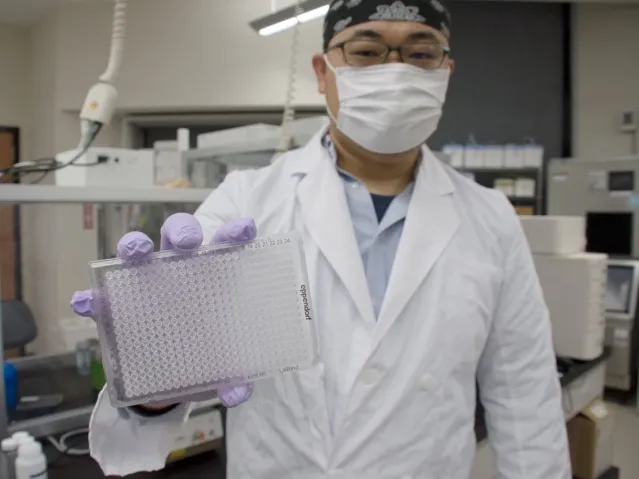Column: Behind the scene of OIST PCR testing

The latest OIST column in the Asahi Shimbun GLOBE+ is out now! This month, Tomomi Okubo, Manager of the Media Relations Section interviewed Dr. Toshinori Tanaka and Mr. Manabu Fujie about the process how to establish the OIST PCR testing system.
The article is in Japanese, but the English translation can be read below.
---
Under the current pandemic of COVID-19, many universities and graduate schools may be refraining from in-person classes and operations and continuing online schooling and remote work.
However, at Okinawa Institute of Science and Technology Graduate University (OIST), staff, researchers, and students have been continuing to work and study on campus every day, just as they did before the pandemic.
This is because OIST has its own PCR testing system uniquely realized by the efforts by the collective minds who lead the science field.
OIST’s own PCR testing system was established in May 2020. This was at a time when the infections started becoming serious in Okinawa Prefecture.
Since OIST does not have a department of medicine or associated hospital, the community needed to come up with the idea on where and by whom the PCR testing should be conducted. OIST has a team of technicians specialized in DNA sequencing of living organisms. They prepare samples taken from organisms, conduct genome sequencing using the machines, and pass the results on to the researchers. These technicians with extensive experience in basic biological experiments were entrusted with the testing. The procedures of inactivating the virus from the specimen and testing them were not so different from the normal procedures of genome sequencing.
In terms of equipment, OIST could technically use the laboratory for normal biological research. However, at the time, we had little knowledge of COVID-19 and there was a concern of the possibility of infection from the specimens. Therefore, OIST set up a dedicated laboratory for PCR testing equipped with a biological safety cabinet away from the other laboratories. After that, the genome sequencing team started to carry out the testing work in parallel with their regular research work.
Now, faculty and staff members who travel outside of Okinawa undergo PCR testing upon their return to keep the virus away from the campus.
Needless to say, the OIST community members also have been making sure to wear masks, disinfect hands, and maintain appropriate social distances. So far, no cluster infection has been reported on campus.
Initially, the PCR testing at OIST was not started to test the faculty and staff members. It was actually launched to support the overstretched medical system across Okinawa.
The effort started back on March 26, 2020. At that time, the number of new infections in Japan was around 100 per day, and the cumulative number of infections exceeded 1,000. People were starting to understand the seriousness of COVID-19.
That day, President, Provost, and several faculty members of OIST led a university-wide online discussion on the topic of "what OIST can do to contribute to research related to COVID-19 and public health.” Faculty members, postdoctoral researchers, and students actively voiced their opinions on what the university could do to contribute to research and the local community.
The biggest concern was that the medical system in Okinawa might suffer constraints in the event of a widespread infection. Being an island, it would be relatively easy for the prefecture to limit the entry of infected people. However, the number of sickbeds for COVID-19 patients was limited to about 200 for the population of approximately 1.45 million, and the number of institutions that could perform PCR testing was also limited, with only a few hundred specimens being collected per day.
The OIST researchers agreed that it was necessary to establish a system so that people on the island would be prepared to respond to any scenarios by themselves. This led to the bold idea of establishing a PCR testing system and performing the tests at OIST to expand the PCR testing capacity in Okinawa.
In the discussion, other ideas also came up to contribute to the local community including the following:
(1) Establishment of antibody testing to determine the number of infections,
(2) Various ideas of basic research to understand the virus,
(3) Production and distribution of substitute for alcohol gel, which was difficult to obtain at the time,
(4) Production of face shields to be used in hospitals in the prefecture, and
(5) Activities to promote hand washing to local residents, etc.
All these ideas were implemented later. In addition, some researchers inspired by this discussion later started working on research that had not been brought up at the time. So far, about 15 projects have been published.
In the launch of the PCR testing, numbers of people were involved in various ways. One of the people who had been deeply involved from the time of discussion in March 2020 was Dr. Toshinori Tanaka, a staff member who supports OIST's research in the area of health and safety.
Dr. Tanaka coordinated with the Okinawa Prefectural Government's task force for pandemic influenza and other infectious diseases and National Institute of Infectious Diseases to ensure that OIST meets the requirements of the laws to conduct the PCR testing. It was shortly after the task force had been set up at the prefectural office with little precedent. Therefore, it took a lot of time and efforts to coordinate the system. At one point, Dr. Tanaka even had about more than 50 prefectural employees cc’d in his e-mails. Once the necessary conditions for a testing center were established, the next step was to complete the contractual procedures between the prefecture and OIST, to make sure the OIST has been registered as a sanitary laboratory,followed by training of the OIST staff on the testing procedures by Okinawa Prefectural Institute of Health and Environment, which was the only institution in the prefecture to conduct PCR testing at the time. After that, Dr. Tanaka obtained the specimens of positive test result to test the technical procedures before starting the actual testing. Dr. Tanaka was involved in every step of the way of coordination, negotiation, and paperwork.
Furthermore, given the risk which the technical specialists would be exposed to in conducting the tests, revisions needed to be made on their job descriptions in their contract so that they could engage in different tasks than their usual research work. Everyone involved in this revision in the university including the technicians themselves acted swiftly to make this change.
At last, on May 1, 2020, OIST became the third testing provider in Okinawa. And in the following June, OIST began offering free testing to the university community.
As of May 2021, OIST has tested 20,000 specimens on behalf of the prefecture and neighboring municipalities.
At OIST, research related to genome sequencing has been conducted frequently. It has attracted considerable attention in the scientific community as the first institution in the world to decode the entire genomes of corals, starfish, pearl oysters, etc. The Sequencing Section, a team of technical specialists who support the researchers behind the scenes, has one of the most advanced expertise in Japan when it comes to the preparation of biological samples. When the technical expert, Mr. Manabu Fujie was approached to do PCR testing outside the scope of his usual work, he thought, "If we combine our experimental techniques, we may be able to conduct more efficient and accurate tests.” He was confident that the team could properly eliminate the risk of the virus and conduct tests accurately with their advanced skills. Mr. Fujie also highly motivated thinking, " Okinawa Prefecture must come together to create a system to complete inspections in Okinawa Prefecture, which is a remote island. It's a great opportunity for OIST to contribute our expertise.”
The technologies which had been developed at OIST for research became immediately useful in addressing the real-time social issue through the collective efforts by OIST staff to contribute to the local community. This experience not only helped OIST grow as a relatively new research institution celebrating its 10th anniversary, but also helped it become further integrated into the local community.
(Tomomi Okubo, OIST Media Relations Section)














